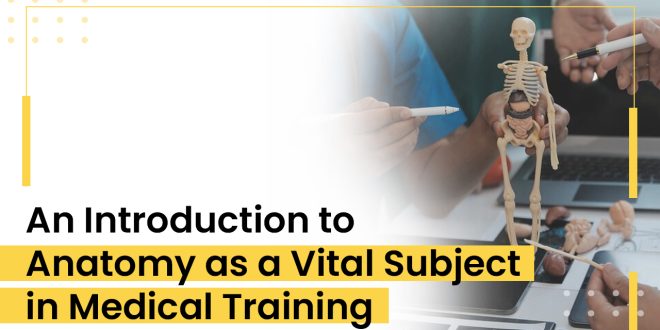Medical education is one of the crucial educational facets among the various educational options available at the global level. This importance of medical education is due to the involvement of human health and lives.
As medical education, especially MBBS creates and deals with the health and well-being of the human population, a wide range of subjects are incorporated into the curriculum of MBBS at leading government and private medical colleges in Mumbai and others.
One such subject that holds great value in the MBBS syllabus is anatomy and we are going to explore this vital subject in this blog.
A glimpse into the Bachelor of Medicine and Bachelor of Surgery courses:
Before getting to know about the vital subject of MBBS, i.e., anatomy, here is a glimpse into the MBBS course for students yet to know about it.
Course Description:
Bachelor of Medicine and Bachelor of Surgery (MBBS) is an undergraduate course exquisitely designed to prepare a student for the medical profession with a curriculum concentrating on all aspects of human health such as various organs of the human body, treatments, and diagnosis of diseases and disorders, etc.
This course is a 5.5-year course divided into 4.5 years of theory classes and 1 year of compulsory rotatory internship in healthcare establishments.
Eligibility Criteria and Admission Process:
The basic eligibility criteria to pursue an MBBS at top MBBS medical colleges in Mumbai and others are as follows:
- Candidates should be a minimum of 17 years of age.
- Candidates should have completed 10+2 with physics, chemistry, and biology as compulsory subjects at any recognised educational institution.
- Candidates should have scored at least 50% aggregate in 10+2.
- Candidates should be NEET qualified.
Admission to MBBS is provided based on the NEET score at the best MBBS colleges in Navi Mumbai and others.
With a brush up about the MBBS degree, let us get to explore about the anatomy subject in the MBBS degree.
What is anatomy?
Anatomy is the branch of biology that deals with the study of the structure of organisms and their parts. In the context of medical science, anatomy primarily focuses on the structure of the human body. It involves the examination of the organization, composition, and relationships between different parts of the body, including organs, tissues, cells, and organ systems.
Why is Anatomy included in the MBBS degree?
Anatomy is considered the foundational subject in the MBBS degree that is essential for understanding any aspect of human health. Knowledge of anatomy is a fundamental necessity for establishing a safe medical career.
Here are some of the reasons why anatomy is included in MBBS degree at leading colleges such as Terna Medical College, one of the best private medical colleges in Mumbai and others:
- Anatomy provides the fundamental understanding of the structure of the human body without which it would be challenging for medical students to comprehend the complexities of physiology, pathology, and clinical medicine.
- Medical students learn to correlate anatomical structures with their functions and clinical significance, enabling them to diagnose diseases, interpret medical imaging, and perform physical examinations accurately.
- Anatomical knowledge is crucial for students planning to take up MS, i.e., surgical speciality courses at top MD colleges in Mumbai and others.
- Anatomical knowledge forms the basis for interdisciplinary collaboration among healthcare professionals such as radiologists, physiotherapists, or surgeons.
To understand the importance of anatomy in an MBBS degree at leading private medical colleges in Navi Mumbai, let us get to know what you will learn under anatomy.
What does anatomy subject teach you in MBBS?
The subject of anatomy in MBBS is divided into the following facets, each of which educates anatomy students in different dimensions.
| Anatomy Facets | Description | What do MBBS students learn? |
| Gross Anatomy | Gross Anatomy is the study of anatomical structures that are visible to the naked eye. | ● Students learn about the organization and relationships of organs, muscles, bones, nerves, blood vessels, and other tissues in the human body.
● Dissection of cadavers is often an integral part of learning gross anatomy, allowing students to observe and explore anatomical structures firsthand. |
| Microscopic Anatomy (or) Histology | Histology focuses on the study of tissues at the microscopic level. | ● Students learn about the structure and function of different types of tissues, including epithelial, connective, muscular, and nervous tissues.
● They study cellular morphology, tissue organization, and histological features of various organs and systems. |
| Developmental Anatomy (or) Embryology | Embryology involves the study of the development of the human body from conception to birth. | ● Students learn about embryonic development, organogenesis, and fetal growth.
● Understanding embryology is essential for comprehending congenital abnormalities, developmental disorders, and the evolution of anatomical structures. |
| Neuroanatomy | Neuroanatomy focuses on the structure and function of the nervous system, including the brain, spinal cord, and peripheral nerves. | ● Students learn about the organization of the central and peripheral nervous systems, neurovascular supply, and neural pathways.
● Knowledge of neuroanatomy is essential for understanding neurological disorders, brain function, and clinical neurology. |
| Clinical Anatomy | Clinical anatomy integrates anatomical knowledge with clinical practice. | ● Students learn to apply anatomical concepts to physical examination, surgical procedures, and medical imaging interpretation.
● They develop spatial reasoning skills, surgical techniques, and diagnostic reasoning based on anatomical principles. |
| Radiological Anatomy | Radiological anatomy involves the interpretation of medical imaging studies, such as X-rays, CT scans, MRI scans, and ultrasound, in relation to anatomical structures. | ● Students learn to identify anatomical landmarks, normal variants, and pathological changes in imaging studies, aiding in diagnosis and treatment planning. |
Conclusion:
Getting to know about what anatomy teaches you in MBBS has made a clear point that without anatomical knowledge students will not be able to learn anything in MBBS at leading private medical colleges in Mumbai and others. So, we would recommend you to gain anatomical knowledge on forehand if you are planning to take up MBBS.
FAQs:
- Why is anatomy important in medical practice?
Anatomy is important in medical practice as it forms the foundational knowledge of medical education which is essential to understand all other medical concepts and specialities.
- What is the brief introduction to anatomy?
Anatomy is the study of the structure of the body and its parts. It deals with studying the structural facet of the human body in various dimensions.
- What are the types of anatomy?
- Gross Anatomy
- Microscopic Anatomy
- Embryology
- Clinical Anatomy
- Neuroanatomy
- Radiological Anatomy
- Is MBBS a good career option?
Yes, as there is increasing demand for healthcare needs it raises the value of MBBS as a good career option.
 BESTCITYTRIPS
BESTCITYTRIPS




